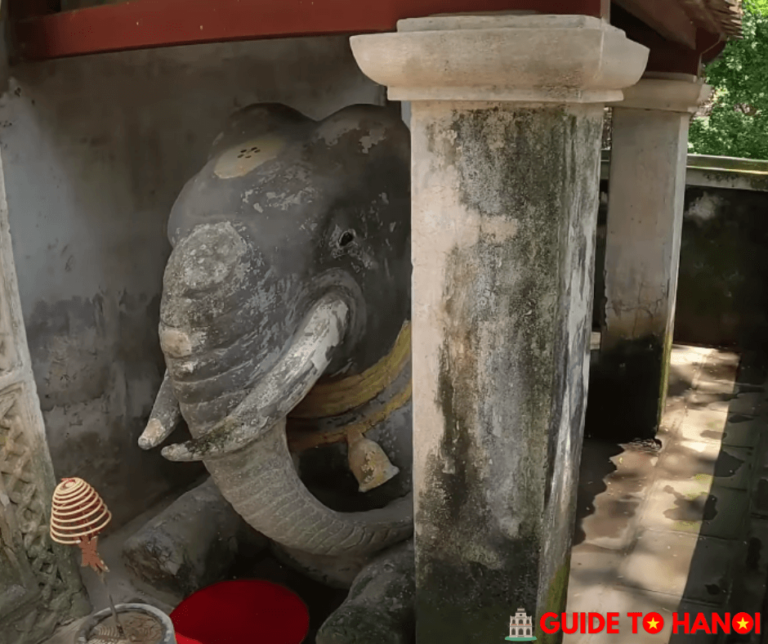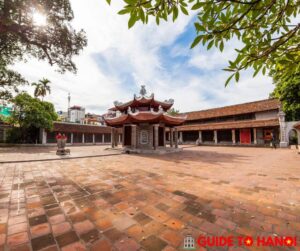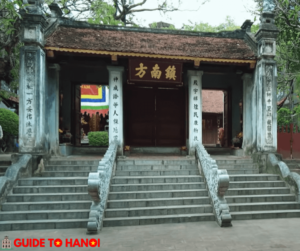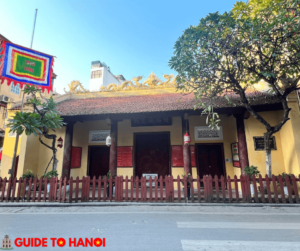Voi Phuc Temple
Voi Phuc Temple, also known as West Town Tu, is a fascinating temple steeped in history and legend in Thang Long’s ancient citadel.
Here’s a closer look at this intriguing site:
Origins and Legends
Established during the reign of Ly Thai Tong, Voi Phuc Temple is dedicated to Prince Linh Lang and his concubine Duong Thi Quang.
Legend has it that Prince Linh Lang, originally named Hoang Chau, played a significant role in Vietnam’s resistance against the Song Dynasty.
The temple’s name, “Voi Phuc,” meaning “Kneeling Elephants,” originates from the two elephant statues at its entrance and westward location in the capital.
Architectural Marvel
The temple’s beautiful and unique architecture blends traditional and recent Vietnamese styles.
Its main gate, adorned with stone horse and elephant steles, leads to a central path flanked by stone-carved cloud dragons.
The temple’s layout, resembling the letter “Cong,” features a five-compartment altar and a middle hall housing a throne dedicated to Linh Lang Dai Vuong.
Restoration and Preservation
Over the years, Voi Phuc Temple has undergone several restoration efforts, including a recent renovation in 2009.
The current temple, more spacious than its original form, is a testament to its cultural and historical significance.
Visitors can explore the temple’s beauty amid lush surroundings, with the facade overlooking a serene lake.
Cultural Significance
The temple’s vibrant annual festival draws participants from far and wide.
This open cultural event highlights the temple’s importance in the region’s cultural and religious practices.
Voi Phuc Temple’s festival is a time-honored tradition that showcases the area’s rich heritage.
Preserving National Identity
Voi Phuc Temple symbolizes Hanoi’s cultural identity, blending history, legend, and architectural beauty.
Its significance transcends time, making it a cherished landmark in the city’s landscape.
Visit Voi Phuc Temple
Experience the allure of Voi Phuc Temple and immerse yourself in its rich history and cultural heritage.
Discover the legends, marvel at the architecture, and partake in the temple’s vibrant festivities.
Voi Phuc Temple is a shining example of Hanoi’s vibrant cultural tapestry.
Explore Voi Phuc Temple’s allure and discover its rich history and cultural heritage.
Experience the legends, marvel at the architecture, and enjoy vibrant festivities.
Voi Phuc Temple is a shining example of Hanoi’s vibrant cultural tapestry.

| Voi Phuc Temple | |
|---|---|
| Location | 362 Kim Ma Street, Ngoc Khanh Ward, Ba Dinh District, Hanoi City |
| Origins | Established during the reign of Ly Thai Tong, dedicated to Prince Linh Lang and Duong Thi Quang |
| Architecture | Reflects a blend of traditional and modern styles, with a five-compartment altar and a central hall housing a throne for Linh Lang Dai Vuong |
| Legends | Named “Voi Phuc” (Kneeling Elephants) due to elephant statues at the entrance and its westward location in the capital |
| Restoration | Underwent several restoration efforts, including a recent renovation in 2009, making the temple more spacious |
| Cultural Significance | The annual festival draws participants from far and wide, showcasing the temple’s importance in the region’s cultural practices. |
| Preservation | Symbol of Hanoi’s cultural identity, blending history, legend, and architectural beauty |
What are the four sacred temples in Hanoi?
The four sacred temples in Hanoi are Bach Ma Temple in the East, Quan Thanh Temple in the North, Voi Phuc Temple in the West, and Kim Lien Temple in the South.
Address:
- 2RH3+WV4, 306B P. Kim Mã, Ngọc Khánh, Ba Đình, Hà Nội




